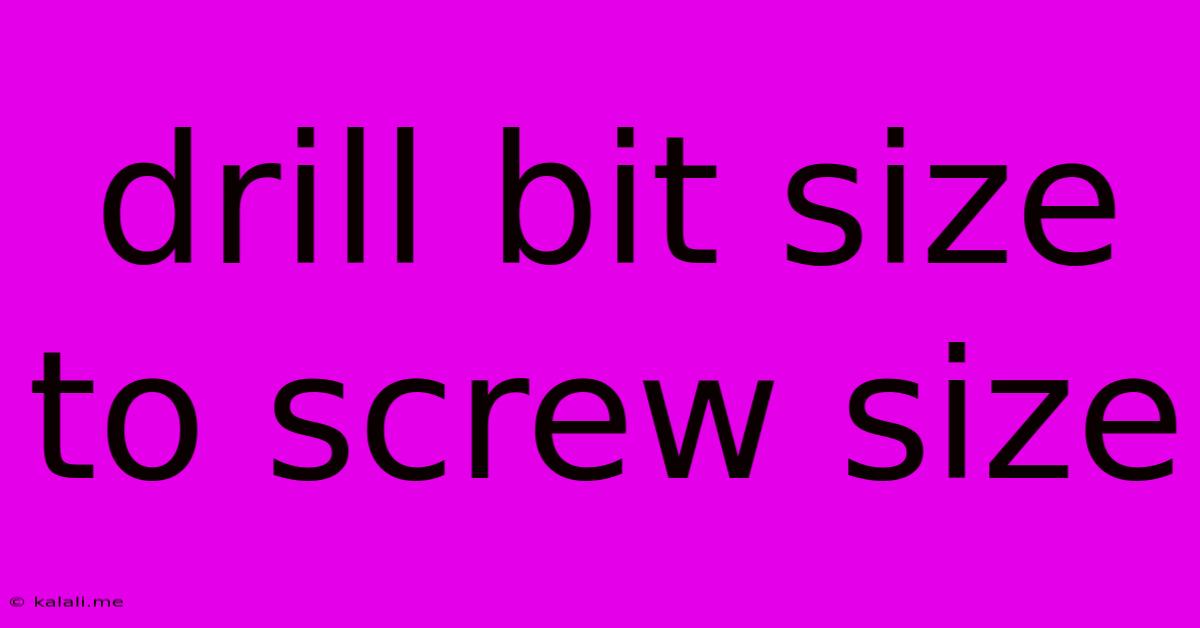Drill Bit Size To Screw Size
Kalali
May 24, 2025 · 3 min read

Table of Contents
Drill Bit Size to Screw Size: A Comprehensive Guide
Choosing the right drill bit size for your screws is crucial for a strong, secure, and aesthetically pleasing finish. Using a bit that's too small can lead to stripped screws and a weak hold, while a bit that's too large can leave the screw loose and prone to falling out. This guide provides a comprehensive overview of matching drill bit sizes to various screw types, helping you achieve professional results every time.
Understanding the Relationship Between Drill Bits and Screws
The purpose of pre-drilling a hole before inserting a screw is twofold: it prevents the wood from splitting, and it provides a smoother, more accurate insertion. The diameter of the drill bit should be slightly smaller than the screw's shank (the unthreaded part of the screw). This allows the screw to grip the wood effectively without excessive force. Choosing the correct size depends on the type of screw, the type of wood, and the desired hold.
Common Screw Types and Corresponding Drill Bit Sizes
This table provides a general guideline. Always refer to the screw manufacturer's recommendations if available, as variations can occur. Consider pilot holes for harder woods.
| Screw Type | Screw Size (Diameter) | Recommended Drill Bit Size | Notes |
|---|---|---|---|
| Wood Screws | #6 (0.138 inches) | 7/64 inch (0.109 inches) | Use a slightly larger bit for harder woods |
| #8 (0.164 inches) | 1/8 inch (0.125 inches) | ||
| #10 (0.190 inches) | 5/32 inch (0.156 inches) | ||
| 1/4 inch (0.250 inches) | 3/16 inch (0.187 inches) | ||
| Sheet Metal Screws | #6 (0.138 inches) | #30 Drill Bit | |
| #8 (0.164 inches) | #25 Drill Bit | For thinner metals, you may not need a pilot hole. | |
| #10 (0.190 inches) | #20 Drill Bit | ||
| Drywall Screws | #6 (0.138 inches) | 7/64 inch (0.109 inches) | Often use a slightly larger hole for easier driving. |
| #8 (0.164 inches) | 1/8 inch (0.125 inches) |
Factors Affecting Drill Bit Selection:
- Wood Type: Hardwoods like oak require slightly larger pilot holes to prevent splitting, while softer woods like pine need smaller holes.
- Screw Length: Longer screws generally benefit from slightly larger pilot holes to reduce the risk of splitting the wood.
- Screw Material: The material of the screw can affect the required pilot hole size, although this is less significant than wood type and screw size.
Tips for Accurate Drilling:
- Use a Drill Guide: A drill guide will ensure straight holes and prevent slippage, which is particularly helpful when working with smaller bits.
- Sharp Drill Bits: A dull drill bit will tear the wood, creating a less precise hole and potentially leading to screw problems.
- Start Slow: Start drilling at a slow speed and gradually increase as the bit penetrates the wood to ensure better control.
Troubleshooting Common Problems:
- Stripped Screws: This often means the pilot hole was too small.
- Split Wood: This indicates the pilot hole was too small or the screw was driven in too forcefully.
- Loose Screws: This implies the pilot hole was too large.
By carefully considering the screw type, wood type, and the tips provided above, you can ensure your screws are properly installed, creating a strong, durable, and professional-looking finish every time. Remember, practice makes perfect! Experiment with different drill bit sizes to find what works best for your projects.
Latest Posts
Latest Posts
-
What Does Ps And Qs Mean
May 25, 2025
-
What Does It Mean To Worship In Spirit And Truth
May 25, 2025
-
How Long Does It Take Wood Glue To Dry
May 25, 2025
-
Outlet Not Working Breaker Not Tripped
May 25, 2025
-
A Place To Keep Track Of Anime Manga Collection
May 25, 2025
Related Post
Thank you for visiting our website which covers about Drill Bit Size To Screw Size . We hope the information provided has been useful to you. Feel free to contact us if you have any questions or need further assistance. See you next time and don't miss to bookmark.